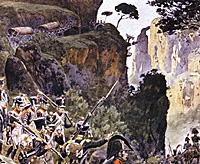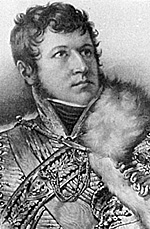 The French Army enters Portugal.
The French Army enters Portugal.
[This is the third of John Grehan's excellent Peninsular War series. I hope I can prevail on him either to extend the series or pen some other articles which, knowing John's high standards, will be both highly interesting and historically accurate. It would be fascinating to discover whether he found the battlefield, when he visited it, to differ in any important way from what he expected or whether it was much as described by Oman and other historians. Is there anything there which might suit for "Fields of Battle" in a future issue, John?]
Historical Background
 In November 1807 a French army of around 25,000 men led by General Androche Junot, Duc d'Abrantes (at right)invaded Portugal. The country succumbed without a shot being fired in its defence and its royal family fled to the safety of the Portuguese colony of Brazil.
In November 1807 a French army of around 25,000 men led by General Androche Junot, Duc d'Abrantes (at right)invaded Portugal. The country succumbed without a shot being fired in its defence and its royal family fled to the safety of the Portuguese colony of Brazil.
Six months later an uprising in Spain against the French inspired the Portuguese who at last took up arms to oppose the invaders. The insurgents appealed to Britain for support, the result of which was the landing of the British army on the northern coast of Portugal.
This body of just 13,000 men under the command of Lieutenant-General Sir Arthur Wellesley (right) was the first contingent of, an expeditionary force which would eventually number around 30,000 men and would be led by another more senior general, Sir Hew Dalrymple.
 Until the arrival of these reinforcements Sir Arthur planned to advance upon the capital, Lisbon, keeping close to the coast so that his men could be supplied by the victualling ships of the fleet and to be ready to cover the disembarkation of the rest of the force, the first two brigades of which were due at any time.
Until the arrival of these reinforcements Sir Arthur planned to advance upon the capital, Lisbon, keeping close to the coast so that his men could be supplied by the victualling ships of the fleet and to be ready to cover the disembarkation of the rest of the force, the first two brigades of which were due at any time.
General Junot, had learnt of the landing of the British troops and he ordered his nearest force, a contingent under General Delaborde, to delay Wellesley until he could assemble the rest of his divisions.
Outside the old walled town of Obidos, British and French troops clashed for the first time in the Peninsula. Delaborde retired into Obidos and the following morning took up a defensive position to the south of the town on a short range of heights in front of the village of Rolica. Wellesley sent his brigades around the flanks of the heights and Delaborde withdrew to a more extensive, semi-circle of hills south of Rolica. Again Wellesley turned Delaborde's position and the French retreated in some disorder. Yet Delaborde had done his job and the British advance had been delayed for a full day.
Wellesley continued his march upon Lisbon only to be informed that the brigades of Acland and Anstruther had arrived off the coast and were waiting to land. The ships sailed to Maceira Bay and Sir Arthur placed his troops on the hills around the village of Vimeiro to cover the disembarkation.
The Battlefield
The village of Vimeiro, sits near the narrow River Maceira at the point where it passes between two ranges of hills on its way to the Atlantic. The hills run in a line from north-east to south-west.
The south-western range, called the Valongo ridge, reaches 300 feet above sea level. It is steep-sided along its length, ending in a high cliff above the sea at its western extremity. The north-eastern range, known as the Mariano Ridge, is sIightIy Iower than the Valongo Ridge and Iess steep but even this was difficult to climb as a ravine follows the base of the ridge for the first mile or sofrom the Maceira river.
The road from Lisbon and Torres Vedras to Lourinha passes by Vimeiro where it branches, with the main road continuing through the village of Maceira and along the coast to Lourinha whilst the branch road runs up and along the broad top of the Mariano ridge. About a mile and a half along the branch road is the hamlet of Ventosa beyond which the heights drop gradually down to their lowest and most accessible part approximately 2 miles from Vimeiro. At this point another road from Torres Vedras joins the Vimeiro-Ventosa-Lourinha road.
In front of Vimeiro village is a low, flat- topped hill which at the time of the battle was covered in vineyards and "thickets," making it an ideal defence. Wellesley, expecting to continue his advance on as soon as all the reinforcements had landed, had left his baggage park behind Vimeiro Hill ready to move off on the morning of the 22nd. The baggage had to be protected at all costs and so the occupation of Vimeiro Hill in the event of a French attack was essential.
Overall, Vimeiro was an excellent choice of position to cover the disembarkation, with clear views of the whole of the likely battlefield area from the top of the Valongo ridge. Its single weakness was that there was only one possible line of retreat in the event of a reverse and that was along the Maceira-Louhrina road to the north-east.
More Vimeiro
- Vimeiro: Introduction
Vimeiro: The Defenders (and British OOB)
Vimeiro: The Attackers (and French OOB)
Vimeiro: The Battle
Vimeiro: Observations
Related
Back to Battlefields Vol. 1 Issue 8 Table of Contents
Back to Battlefields List of Issues
Back to Master Magazine List
© Copyright 1999 by Partizan Press.
This article appears in MagWeb (Magazine Web) on the Internet World Wide Web.
Other military history articles and gaming articles are available at http://www.magweb.com